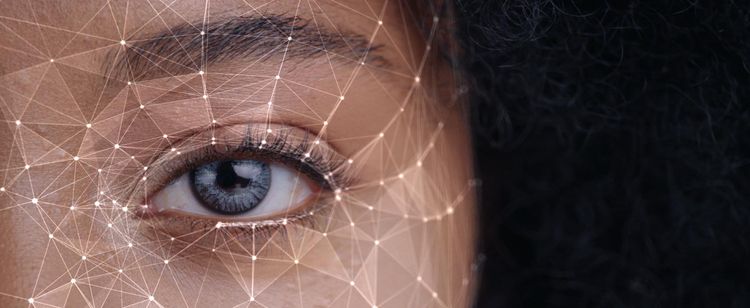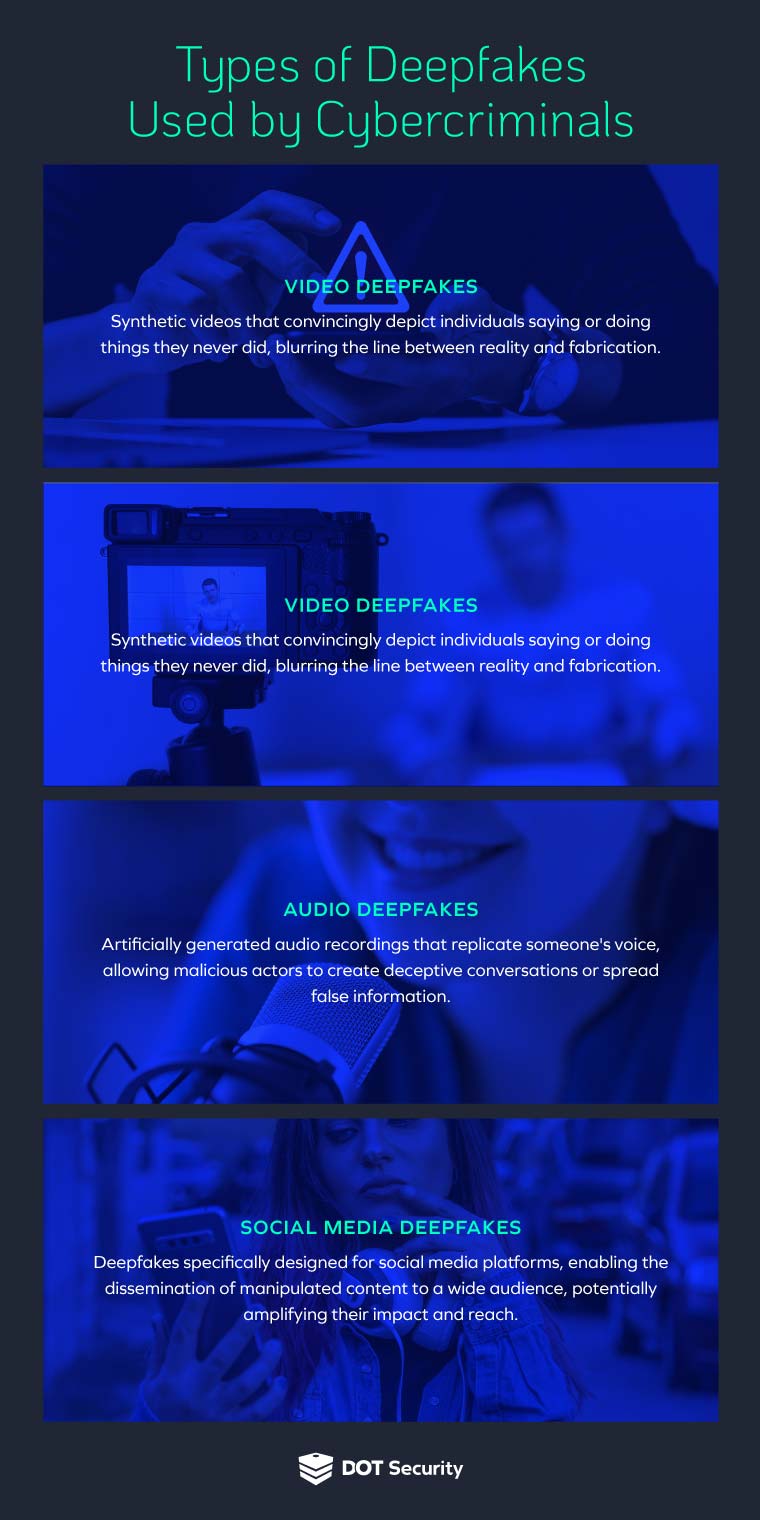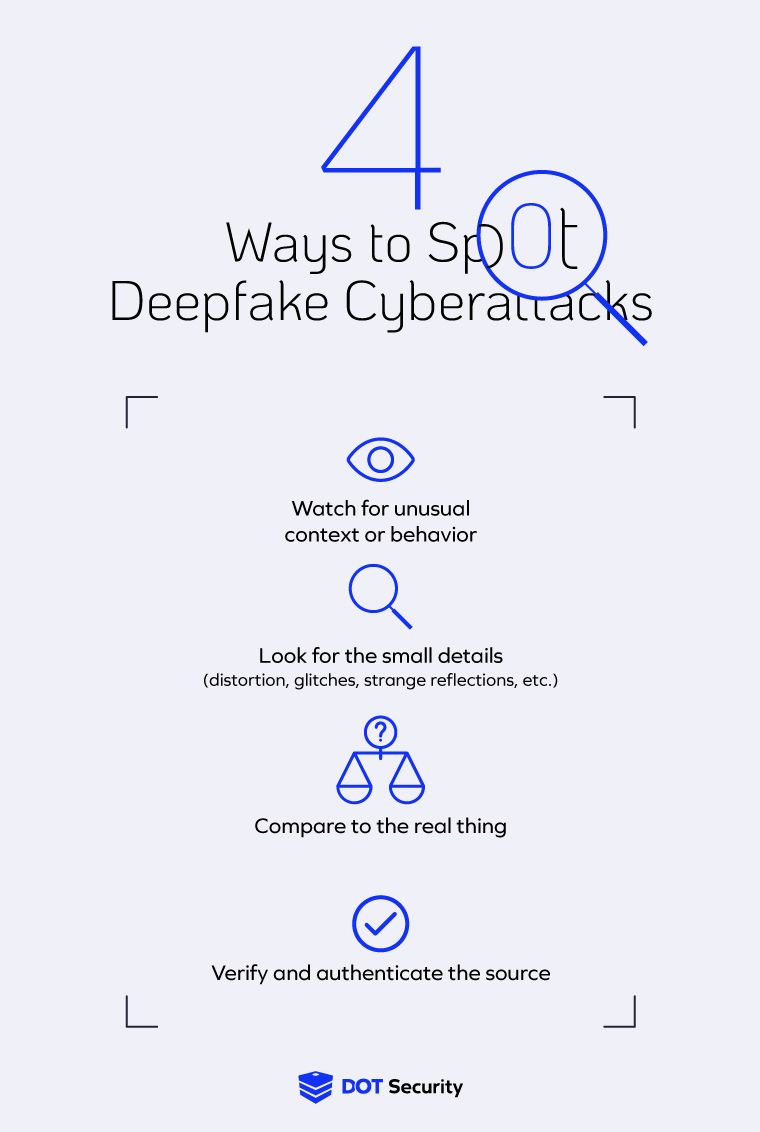Identity And Access Management
Are Deepfakes Illegal & Do They Pose a Risk to Your Business?
August 15, 2024
10 Minutes

Deepfake technology has revolutionized the world of digital media, but also brought out many concerning possibilities, leaving many wondering if deepfakes are illegal, if they’re dangerous, and how to spot them.
Deepfakes, a blend of "deep learning" and "fake," refer to artificially generated media content that convincingly mimics real people’s faces, bodies, and voices. While deepfakes have garnered attention for their entertainment value, they also pose a substantial threat to businesses.
Sign up for our newsletter!
Deepfakes are a new, but serious vulnerability that businesses must be aware of and take precautions against. Download our checklist, Common Vulnerabilities in Cybersecurity & How to Stop Them, to get actionable steps you can take right now to become more secure.
What is a Deepfake?
The definition of a deepfake is any manipulated or synthetic media, primarily images or videos, created using artificial intelligence (AI).
Deepfake algorithms analyze and manipulate existing media, typically images or videos of individuals, to create highly realistic, fabricated content. These convincing fakes can make it appear as though someone said or did something they never did, blurring the line between reality and fiction.
How do Deepfakes Work?
Deepfake technology employs a combination of machine learning, specifically deep neural networks, and generative adversarial networks (GANs) to create lifelike content.
Deep neural networks analyze vast amounts of data to learn the patterns, expressions, and features of the target individual. GANs then generate synthetic content by pitting two neural networks against each other, one attempting to create deepfakes, and the other trying to detect them. This process refines the quality and believability of the generated content over time.
Are Deepfakes Illegal?
Deepfakes are not universally illegal. The legality of them varies depending on the jurisdiction and the specific context in which they are used. While the creation and dissemination of deepfakes itself is not illegal in many countries, the manner in which they are used can lead to legal consequences.
Deepfakes can potentially violate various laws, including those related to privacy, intellectual property, defamation, fraud, and identity theft. For example, using deepfakes to defame someone, commit fraud, or infringe on copyrights can be illegal and subject to legal action. In some jurisdictions—like Virginia, Texas, and California—there are specific laws or regulations that address deepfakes, imposing penalties for malicious uses.
However, the legal landscape surrounding deepfake technology is still evolving, and there are challenges in enforcement due to the ease of creation and distribution. Legislators and policymakers are actively working to address the issue by introducing new laws and regulations to combat the potential harms of deepfakes.
As the technology evolves and the popular opinion of them shifts, it is important for individuals and businesses to stay informed about the laws and regulations in their respective jurisdictions and to exercise caution and ethical responsibility when it comes to creating, sharing, or using deepfakes to avoid potential legal repercussions.
So, the answer to ”are deepfakes illegal?” is a bit of a gray area and mostly depends on where you are and what you’re using the deepfakes for.
Why Deepfakes are Dangerous to Businesses
The dangers of deepfakes are very apparent in the worlds of business, politics, and general culture. Fakes images and videos of industry and political leaders have already made the rounds on social media, tricking people and causing many to question the future of deepfake technology. The overall risks posed by deepfakes to businesses are multifaceted.
First, reputation damage is a significant concern. A malicious actor can create deepfake content involving high-profile executives or employees, causing severe harm to a company's brand and trust among stakeholders. These types of deepfakes can also be used to trick employees into giving up login credentials or exposing sensitive information via voice or video messages.
Additionally, deepfakes can be used for financial fraud, such as manipulating video evidence of transactions or altering audio instructions in critical financial communications. This can lead to losses and legal complications for businesses.
Lastly, the threat of a deepfake is a touch more dangerous because most people are not yet aware that the threat exists. 72% of people are still unaware that deepfakes are being used by bad actors. This means most people aren’t even aware that they should be looking for them.
How Cybercriminals are Using Deepfakes to Attack Businesses
Deepfakes that are dangerous to businesses typically come in a handful of different forms that can be used in a variety of ways, including:
-
Text-Based Deepfakes: Text deepfakes refer to manipulated written content that mimics someone's style, tone, or opinions. These deceptive texts can be used in cyberattacks to spread misinformation, manipulate public opinion, or impersonate individuals. By imitating someone's writing style, hackers can craft convincing messages or posts to deceive readers.
-
Video Deepfakes: Video deepfakes are synthetic videos that convincingly depict individuals saying or doing things they never did. In cyberattacks, video deepfakes are exploited to damage reputations, spread misinformation, or blackmail targets. High-profile figures or politicians may be targeted with the intent to discredit or manipulate public perception.
-
Audio Deepfakes: Audio deepfakes are artificially generated audio recordings that replicate someone's voice. Cybercriminals can leverage audio deepfakes to mimic the voice of a trusted individual or authority figure to deceive victims into carrying out unauthorized actions or divulging sensitive information.

5 Deepfake Cybersecurity Protocols to Stay Secure
To mitigate the risks associated with deepfake technology, businesses need to implement robust cybersecurity measures. Here are some key strategies:
1. Administer Consistent Employee Education
Businesses should educate their employees about deepfake technology, its potential impact, and how to identify and respond to potential threats. This includes raising awareness about social engineering techniques and promoting skepticism when encountering suspicious media content.
By training employees to be cautious and vigilant, businesses can reduce the likelihood of falling victim to deepfake-related attacks.
Related Blog: The Importance of Cybersecurity Awareness, Training, and Education
2. Implement Multi-Factor Authentication
Having multi-factor authentication (MFA) across all platforms adds an extra layer of deepfake cybersecurity, reducing the risk of unauthorized access.
By requiring multiple forms of identification, such as passwords, biometric verification, or security tokens, businesses can protect sensitive information and prevent imposters from gaining control. MFA significantly strengthens the security infrastructure and makes it more challenging for attackers to breach digital systems.
3. Use Deepfake Detection Tools
Investing in detection technology can help businesses improve their deepfake cybersecurity by being able to effectively and quickly identify manipulated media content. These tools utilize AI algorithms to analyze and identify visual or audio anomalies that indicate the presence of deepfakes.
By employing advanced algorithms and machine learning models specifically designed for deepfake detection, businesses can enhance their ability to detect and mitigate potential threats.
4. Establish Media Verification Processes
When faced with potentially sensitive or influential media content, businesses should adopt a rigorous and universal verification process across their entire organization. This may involve seeking expert opinions, consulting trusted sources, or using third-party verification services.
By independently verifying the authenticity of media content before making critical decisions based on it, businesses can protect themselves from the consequences of deepfake manipulation.
5. Build an Incident Response Plan
Having a well-defined incident response plan is crucial in addressing deepfake-related incidents promptly and effectively. The plan should include predefined steps for detecting, reporting, and mitigating the impact of deepfake attacks. By establishing clear protocols and assigning responsibilities, businesses can minimize the damage caused by deepfakes and swiftly implement countermeasures.
Tips to Identify Deepfakes and Prevent Security Failures
Identifying deepfake technology attacks can be challenging as they continue to evolve and produce increasingly realistic content. However, there are several key tips that can help businesses and individuals recognize potential deepfake threats.

Be Cautious of Unusual Context or Behavior
One common characteristic of deepfakes is the presence of unusual or out-of-context behavior. Pay close attention to any media content that seems out of character for the person or situation involved.
Look for subtle inconsistencies in facial expressions, body language, or voice patterns that don't align with what you would expect. Deepfakes often manipulate context, so if something feels off, it's worth investigating further.
Scrutinize Fine Details
Deepfakes may exhibit certain imperfections that can give them away upon closer inspection. Look for glitches, distortions, or artifacts in the video or image, such as inconsistent lighting, blurriness, or strange reflections.
Pay attention to details like hair movements, eye blinks, or teeth alignments, as these can be challenging to recreate convincingly. Analyzing the fine details can help reveal signs of manipulation.
Compare with Authentic Sources
When encountering media content that could potentially be a deepfake, compare it with authentic and verified sources. Seek out multiple angles, interviews, or recordings of the person or event in question. By cross-referencing with trusted sources, you can identify discrepancies or inconsistencies between the original content and the potentially manipulated deepfake version.
Verify the Source
Before accepting media content at face value, ensure it comes from a reliable and trustworthy source. Deepfake attacks often rely on spreading misinformation through social media, anonymous accounts, or unverified platforms. Verify the credibility of the source, check for a track record of accurate reporting, and consider the reputation and expertise of the entity sharing the content.
Stay Informed and Use Deepfake Detection Tools:
As deepfake technology advances, so does the development of tools designed to detect and identify them. Stay informed about the latest advancements in deepfake detection and consider using reputable deepfake detection tools.
These tools employ advanced algorithms and machine learning techniques to analyze media content for signs of manipulation. While not foolproof, they can provide an additional layer of defense against deepfake attacks.
Key Takeaways
-
Deepfakes are not universally illegal, and the legality of their creation and dissemination depends on the jurisdiction and context
-
Deepfakes pose significant dangers to businesses, including reputation damage, financial fraud, and manipulation of critical communications
-
Cybercriminals use various forms of deepfakes, such as text-based, video, and audio deepfakes, to carry out attacks, spread misinformation, and deceive individuals
-
To stay secure from deepfake threats, businesses should prioritize employee education, implement multi-factor authentication, use deepfake detection tools, establish media verification processes, and build an incident response plan
-
Businesses and individuals can identify deepfakes by being cautious of unusual context or behavior, scrutinizing fine details, comparing with authentic sources, verifying the source, and staying informed about deepfake detection tools
Wrapping Up on Deepfakes
Deepfakes present significant risks to businesses, including reputation damage and financial fraud. While their legality varies, modern organizations need to account for deepfakes in their cybersecurity strategies. Deepfakes are not universally illegal and are being used by people for both good and bad reasons every day.
It’s now on the shoulders of the business to install thorough cybersecurity measures, train their employees, and build out recovery plans if an incident does ever occur. By staying cautious, scrutinizing content, verifying sources, and leveraging detection technologies, organizations can build resilience and greatly improve security overall.
Cover your business' biggest weaknesses and vulnerabilities before cybercriminals can take advantage of them. Download the checklist, Common Vulnerabilities in Cybersecurity & How to Stop Them, today to learn what you can do today to become more secure.
